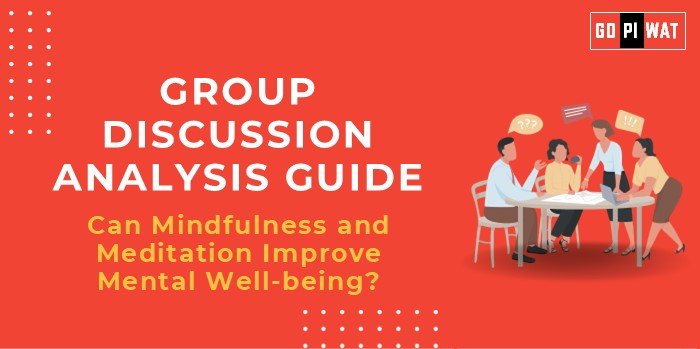📋 Group Discussion Analysis Guide: Can Mindfulness and Meditation Improve Mental Well-being?
🌐 Introduction to the Topic
- 📜 Opening Context: “In a world increasingly burdened by stress and mental health challenges, mindfulness and meditation have emerged as potential game-changers for mental well-being.”
- 📖 Topic Background: Rooted in ancient traditions like Buddhism, mindfulness and meditation have gained modern prominence through scientific validation and advocacy by global wellness leaders. Their adoption spans workplaces, schools, and even clinical therapy programs.
📊 Quick Facts and Key Statistics
- 💡 Mental Health Costs: The global economy loses approximately $1 trillion annually due to depression and anxiety (WHO, 2023).
- 📱 Meditation Growth: Apps like Calm and Headspace reported a 200% rise in downloads during the COVID-19 pandemic.
- 📚 Clinical Validation: Over 1,000 studies validate mindfulness-based stress reduction (MBSR) as an effective therapy for anxiety and depression.
- 📈 Employee Productivity: Mindfulness programs in workplaces have boosted productivity by 12% (Harvard Business Review, 2023).
👥 Stakeholders and Their Roles
- 🏥 Healthcare Professionals: Promote mindfulness as a therapeutic tool for mental health.
- 🏢 Corporations: Implement workplace meditation programs to enhance employee productivity.
- 🏛️ Governments: Advocate mental health initiatives incorporating meditation.
- 🧘 Individuals: Embrace practices to improve personal well-being.
- 📊 Researchers: Validate practices with evidence-based studies.
🏆 Achievements and Challenges
✨ Achievements
- 💊 Clinical Success: MBSR reduces symptoms of PTSD and anxiety in 70% of cases.
- 💼 Corporate Wellness: Companies like Google and Intel integrate mindfulness programs, reporting higher job satisfaction.
- 🏫 Educational Integration: Schools incorporating meditation show a 20% decline in behavioral issues.
- 🌍 Cultural Acceptance: Meditation is no longer niche; it is embraced across diverse cultural and age groups.
⚠️ Challenges
- 🚪 Accessibility Issues: Programs are often inaccessible to marginalized communities.
- 🔬 Scientific Skepticism: Some experts debate the replicability of research findings.
- ⏳ Adherence Rates: Many individuals struggle with consistency in mindfulness practices.
- 🎭 Cultural Misappropriation: Concerns about the dilution of meditation’s cultural origins.
Global Comparisons:
• United States: Proliferation of apps and wellness programs.
• India: Government-promoted yoga and meditation initiatives.
• Japan: Zen practices integrated into daily corporate life.
Case Studies:
• India: The Art of Living Foundation reaches 156 countries, promoting mental health through mindfulness.
• United States: Veterans Affairs uses mindfulness for PTSD recovery in war veterans.
📢 Structured Arguments for Discussion
- 💬 Supporting Stance: “Mindfulness programs, validated by over 1,000 scientific studies, have transformed workplaces, schools, and therapy clinics globally.”
- 🗣️ Opposing Stance: “Mindfulness may not work universally; accessibility issues and lack of rigorous regulation in training programs limit its reach.”
- ⚖️ Balanced Perspective: “While mindfulness has clear mental health benefits, its success depends on accessibility, cultural sensitivity, and consistent practice.”
📈 Effective Discussion Approaches
- 💡 Opening Approaches:
- “With mental health costing the global economy $1 trillion annually, could mindfulness be the solution?”
- “From Silicon Valley to classrooms, mindfulness is heralded as a remedy for our mental health crisis.”
- 💡 Counter-Argument Handling:
- “Adherence is an issue, but digital apps are bridging this gap.”
- “Public funding can make mindfulness accessible in underserved areas.”
📊 Strategic Analysis of Strengths and Weaknesses
Strengths
- 📈 Scientifically validated for reducing stress and improving well-being.
- 💰 Cost-effective compared to traditional therapy.
Weaknesses
- 🔒 Access barriers for marginalized groups.
- ⏳ Inconsistent adherence rates among participants.
Opportunities
- 🌐 Expansion via digital platforms and mobile apps.
- 🏢 Integration into workplaces and educational institutions.
Threats
- 🎭 Cultural resistance or misappropriation concerns.
- 📉 Limited impact in poorly designed programs.
🎓 Connecting with B-School Applications
- 💡 Real-World Applications:
- Topics for leadership programs and stress management in high-pressure roles.
- Projects integrating mindfulness into operational strategy.
- 💡 Sample Interview Questions:
- “Can mindfulness be scaled globally for workplace mental health?”
- “Evaluate the ROI of meditation in corporate settings.”
- 💡 Insights for Students:
- Develop programs integrating mindfulness into operations.
- Strategize on making mindfulness programs scalable for diverse populations.
- Explore the role of digital platforms in scaling mental health interventions.


